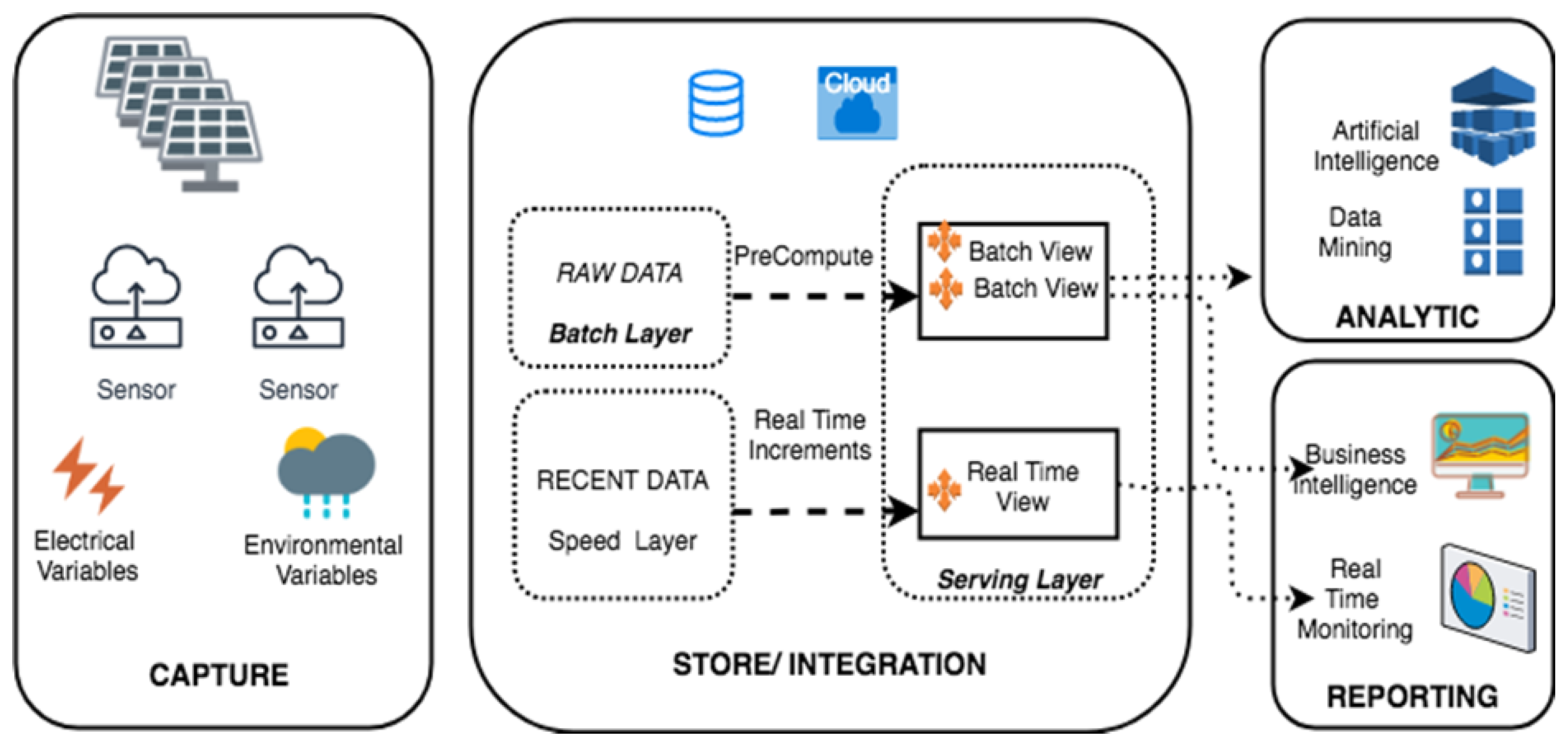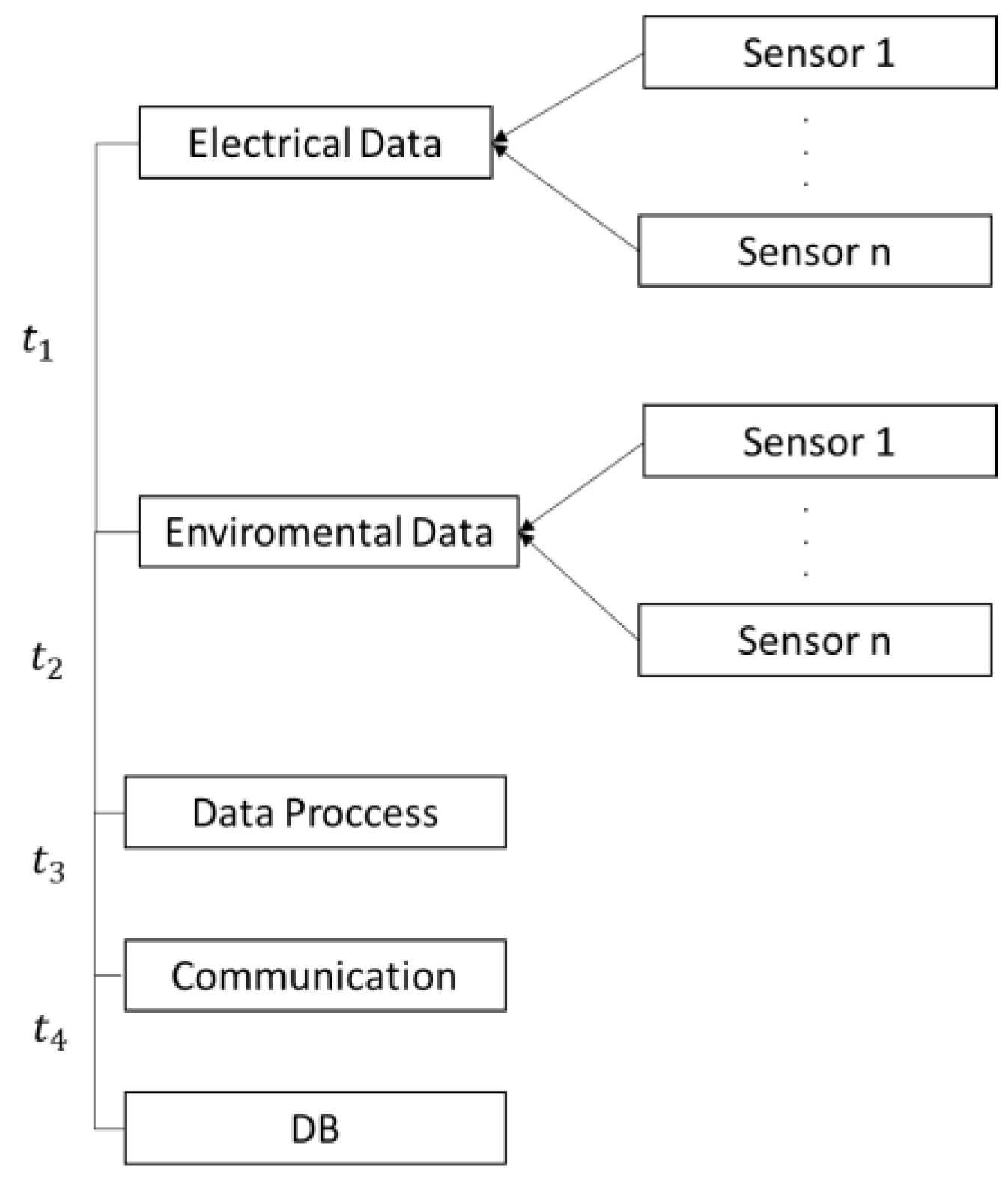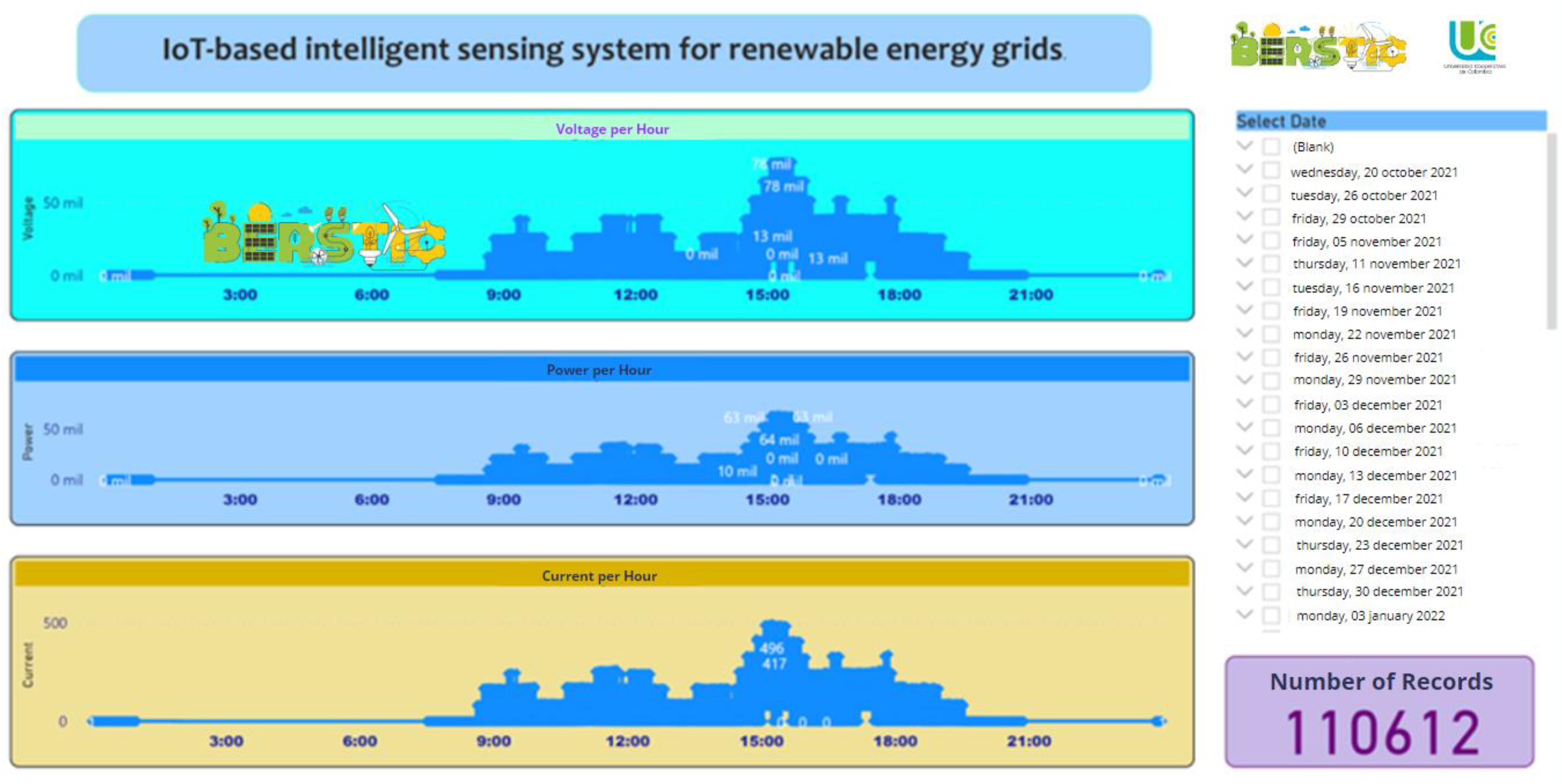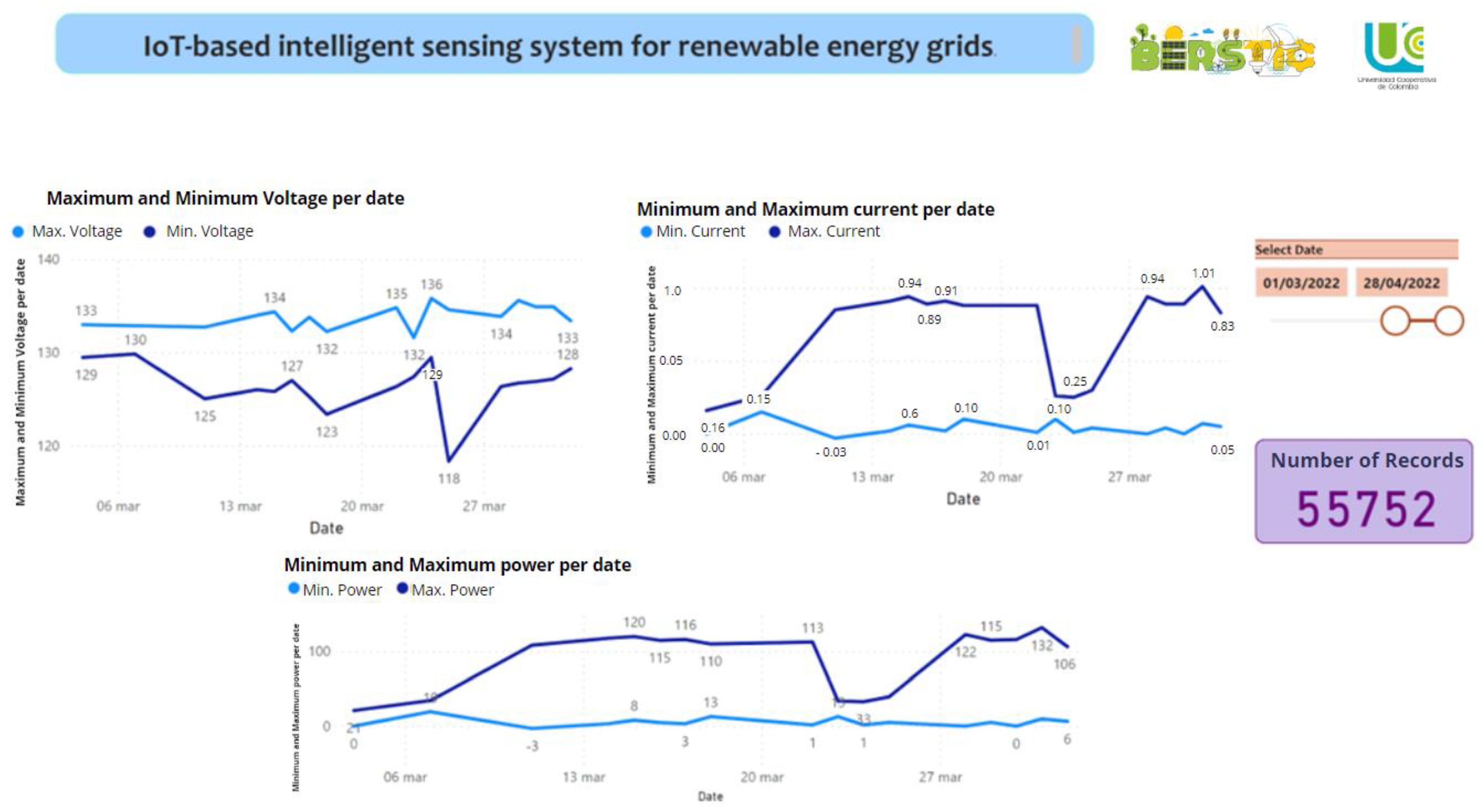A Data-Driven Architecture for Smart Renewable Energy Microgrids in Non-Interconnected Zones: A Colombian Case Study
Abstract
:1. Introduction
2. Background
2.1. Smart Grids
2.2. Data Management in Smart Grids
- Microsoft: This reference architecture is a high-level diagram focused on data, representing the flow of big data and the possible transformation of data, from their collection to their use. This data transformation model includes data collection, aggregation, comparison, and mining.
- Big Data Architecture Framework (BDAF): This framework focuses on the definition of the infrastructure and services based on Cloud/Intercloud technologies focused on the reference architecture of Big Data Security from IBM. It supports all types of data processing and management and maps out, among others, data discovery and exploration, data analysis, the management of unstructured data, real-time data analysis, analytical functions and toolsets, governance, event detection and action, security, and business continuity.
- An important issue in the management and control of smart grids is ensuring the security and quality of the data being handled, as this, along with other technical aspects, is what the functionality of the grid is all about. Regarding data security, various methods can be implemented, such as encryption, access controls, and cybersecurity protocols to safeguard information and guarantee confidentiality, integrity, and availability at any time. Nowadays, due to the rate of digital advances, it is essential to study this aspect to create comprehensive and secure solutions. The authors of [27] carried out an exercise on image encryption, since the correct transmission of images was fundamental for their study. Additionally, the authors of [28] used neural networks to create methods for protection against cyberattacks. Moreover, the authors of [29] implemented techniques to improve image authentication. These are all examples of the great advances in data security and the importance of proper data transmission and management.
- ORACLE: Oracle offers an integrated solution to address big data requirements in an application context driven by big data requirements for data acquisition, organisation, and analysis in support of decision making.
- PIVOTAL: This model provides a variety of open-source platforms, EMC technology, and VMware, with the goal of making it possible to build big data analysis apps designed for the cloud.
- SAP Big Data Architecture: This architecture includes data lifecycle management, infrastructure management, and data governance and security.
3. Methodology
- A total of 77% of the population’s basic needs are unsatisfied.
- Scattered and remote areas with a low population density.
- Low average consumption.
- Low payment capacity.
- Lack of adequate monitoring and control mechanisms.
- Little or no internet connectivity.
- Low appropriation of ICT and energy technologies.
- Geographical, environmental, and social conditions such as nature reserves, jungle areas, deserts, indigenous areas, and armed conflict zones.
3.1. Functional Requirements (FR)
3.1.1. FR—Data Capture
- Capture data in real-time and asynchronously (mainly sensor or open data).
- Transmit through at least two flexible communication protocols (wired and wireless), guaranteeing QoS depending on the area’s connectivity conditions.
- Scale capture to unstructured data (video, images, voice) for future versions.
3.1.2. FR—Integration and Storage
- Sample processing and transformation of captured data into a defined format.
- Define a data mart to facilitate the data analysis.
- Support batch and real-time analytical processing (locally and in the cloud).
- Support big data processing for analysis and modelling.
- Ensure data quality.
- Define a backup policy for stored data.
3.1.3. FR—Data Analysis and Information Visualisation and Reporting
- Enable searches of processed data with relevance, accuracy, and retrieval.
- Support diversified output file formats for viewing and reporting both on the web.
- Generate a simple user interface for viewing results in real-time via web and mobile devices that support these zones’ connectivity limitations.
- Support data analysis and visualisation for business intelligence, data mining, and artificial intelligence through web and mobile devices that support these zones’ connectivity limitations.
- Facilitate the interpretation of results for potential users with few technological skills.
- Dynamic updating of generated and processed data.
3.2. Non-Functional Requirements (NFR)
- Data Security: In the current framework for the case study and in the tests performed, no attack prevention mechanisms have been considered, given the current maturity level of the project. In addition to the challenge of improving security for low-capacity processing devices such as Arduinos, the main objective at this stage is to validate the functionality of the framework. However, it is possible to incorporate security measures when transmitting data to the server, which may involve data encryption or some methodologies to counter cyberattacks, as studied by [36,37]. However, the selection of the most appropriate security method will require experimentation and validation, considering power and processing requirements, which are critical constraints on data sensing.
- Privacy policy for sensitive data.
- The ability of the system to be scaled up according to the conditions in the area.
- The standardisation, aggregation, and normalisation of data.
3.3. Reference Model
4. Results and Discussion
- The prediction of energy generation and consumption from the analysis is possible and can be used for multiple purposes, including future production planning.
- Sustainable and efficient network operation can be improved through the computational analysis of real-time data.
- Evaluating the data flow of electrical signals, such as current, voltage, etc., allows to one monitor and analyse the power quality of the microgrid and identify errors in the sensors.
- Energy technology monitoring and predictive failure analysis will enable predictive maintenance and make it possible to identify the actual degradation rates of the network components.
- The analysis of consumption patterns will allow for the generation of sustainable business models for communities, which is an important factor for the self-sufficiency of these communities and their energy projects.
- The discovery of value and knowledge about this NIZ will facilitate microgrid implementations in similar contexts.
- Weather forecasts can be analysed to select the most appropriate energy generation technology.
- The information generated supports feasibility studies of renewable energy projects for other NIZs.
5. Conclusions
Author Contributions
Funding
Data Availability Statement
Conflicts of Interest
References
- DNP. Plan Nacional de Desarrollo 2018–2022; Departamento Nacional de Planeación: Bogotá, Colombia, 2018.
- Colmenares-Quintero, R.F.; Maestre-Gongora, G.; Baquero-Almazo, M.; Stansfield, K.E.; Colmenares-Quintero, J.C. Data Analysis of Electricity Service in Colombia’s Non-Interconnected Zones through Different Clustering Techniques. Energies 2022, 15, 7644. [Google Scholar] [CrossRef]
- Superintendencia de Servicios Públicos Domiciliarios Diagnóstico de la Prestación del Servicio de Energía Eléctrica.Zonas no Interconectadas-Zni 2018. Available online: https://www.superservicios.gov.co/sites/default/files/inline-files/diagnostico_de_la_prestacion_del_servicio_zni_-_07-11-2019-lo_1%20%281%29.pdf (accessed on 2 June 2023).
- Congreso de Colombia Ley 0855 de 2003. 2003. Available online: http://www.secretariasenado.gov.co/senado/basedoc/ley_0855_2003.html (accessed on 2 June 2023).
- BID Parte I Antecedentes y Marco Conceptual Del Análisis, Evaluación y Recomendaciones para la Implementación de Redes Inteligentes En Colombia. Smart Grids Colombia Vision 2016, 2030. Available online: https://www1.upme.gov.co/Paginas/Smart-Grids-Colombia-Visi%C3%B3n-2030.aspx (accessed on 2 June 2023).
- Zhou, K.; Fu, C.; Yang, S. Big Data Driven Smart Energy Management: From Big Data to Big Insights. Renew. Sustain. Energy Rev. 2016, 56, 215–225. [Google Scholar] [CrossRef]
- Mera-Paz, J.A. Gamificación una estrategia de fortalecimiento en el aprendizaje de la ingeniería de sistemas, experiencia significativa en la Universidad Cooperativa de Colombia sede Popayán. Rev. Científica 2016, 26, 3–11. [Google Scholar]
- Colmenares-Quintero, R.F.; Valderrama-Riveros, O.C.; Macho-Hernantes, F.; Stansfield, K.E.; Colmenares-Quintero, J.C. Renewable Energy Smart Sensing System Monitoring for Off-Grid Vulnerable Community in Colombia. Cogent Eng. 2021, 8, 1936372. [Google Scholar] [CrossRef]
- Khan, S.; Paul, D.; Momtahan, P.; Aloqaily, M. Artificial Intelligence Framework for Smart City Microgrids: State of the Art, Challenges, and Opportunities. In Proceedings of the 2018 Third International Conference on Fog and Mobile Edge Computing (FMEC), Barcelona, Spain, 23–26 April 2018; pp. 283–288. [Google Scholar]
- Pawar, P.; Vittal, K.P. Design and Development of Advanced Smart Energy Management System Integrated with IoT Framework in Smart Grid Environment. J. Energy Storage 2019, 25, 100846. [Google Scholar] [CrossRef]
- Babadi, A.N.; Nouri, S.; Khalaj, S. Challenges and Opportunities of the Integration of IoT and Smart Grid in Iran Transmission Power System. In Proceedings of the 2017 Smart Grid Conference (SGC), Tehran, Iran, 20–21 December 2017; pp. 1–6. [Google Scholar]
- Yaghmaee, M.H.; Hejazi, H. Design and Implementation of an Internet of Things Based Smart Energy Metering. In Proceedings of the 2018 IEEE International Conference on Smart Energy Grid Engineering (SEGE), Oshawa, ON, Canada, 12–15 August 2018; pp. 191–194. [Google Scholar]
- Saha, S.; Mondal, S.; Saha, A.; Purkait, P. Design and Implementation of IoT Based Smart Energy Meter. In Proceedings of the 2018 IEEE Applied Signal Processing Conference (ASPCON), Kolkata, India, 7–9 December 2018; pp. 19–23. [Google Scholar]
- Stusek, M.; Pokorny, J.; Masek, P.; Hajny, J.; Hosek, J. A Non-Invasive Electricity Measurement within the Smart Grid Landscape: Arduino-Based Visualization Platform for IoT. In Proceedings of the 2017 9th International Congress on Ultra Modern Telecommunications and Control Systems and Workshops (ICUMT), Munich, Germany, 6–8 November 2017; pp. 423–429. [Google Scholar]
- Choi, C.-S.; Jeong, J.-D.; Lee, I.-W.; Park, W.-K. LoRa Based Renewable Energy Monitoring System with Open IoT Platform. In Proceedings of the 2018 International Conference on Electronics, Information, and Communication (ICEIC), Honolulu, HI, USA, 24–27 January 2018; pp. 1–2. [Google Scholar]
- Tauqir, H.P.; Habib, A. Integration of IoT and Smart Grid to Reduce Line Losses. In Proceedings of the 2019 2nd International Conference on Computing, Mathematics and Engineering Technologies (iCoMET), Sukkur, Pakistan, 30–31 January 2019; pp. 1–5. [Google Scholar]
- Barman, B.K.; Yadav, S.N.; Kumar, S.; Gope, S. IOT Based Smart Energy Meter for Efficient Energy Utilization in Smart Grid. In Proceedings of the 2018 2nd International Conference on Power, Energy and Environment: Towards Smart Technology (ICEPE), Shillong, India, 1–2 June 2018; pp. 1–5. [Google Scholar]
- Alhebshi, F.; Alnabilsi, H.; Alzebaidi, J.; Bensenouci, A.; Brahimi, T.; Bensenouci, M.-A. Monitoring the Operation of Transmission Line in a Smart Grid System through IoT. In Proceedings of the 2018 15th Learning and Technology Conference (L&T), Jeddah, Saudi Arabia, 25–26 February 2018; pp. 139–146. [Google Scholar]
- Pathak, K.S.; Darbari, M.; Yagyasen, D.; Ahmed, H. Making Renewable Energy SMART Using Internet of Things (IOT). In Proceedings of the 2014 International Conference on Advances in Engineering & Technology Research (ICAETR 2014), Unnao, India, 1–2 August 2014; pp. 1–4. [Google Scholar]
- Nayanatara, C.; Divya, S.; Mahalakshmi, E.K. Micro-Grid Management Strategy with the Integration of Renewable Energy Using IoT. In Proceedings of the 2018 International Conference on Computation of Power, Energy, Information and Communication (ICCPEIC), Chennai, India, 28–29 March 2018; pp. 160–165. [Google Scholar]
- Tu, C.; He, X.; Shuai, Z.; Jiang, F. Big Data Issues in Smart Grid—A Review. Renew. Sustain. Energy Rev. 2017, 79, 1099–1107. [Google Scholar] [CrossRef]
- Wilcox, T.; Jin, N.; Flach, P.; Thumim, J. A Big Data Platform for Smart Meter Data Analytics. Comput. Ind. 2019, 105, 250–259. [Google Scholar] [CrossRef]
- Diamantoulakis, P.D.; Kapinas, V.M.; Karagiannidis, G.K. Big Data Analytics for Dynamic Energy Management in Smart Grids. Big Data Res. 2015, 2, 94–101. [Google Scholar] [CrossRef]
- Sagiroglu, S.; Terzi, R.; Canbay, Y.; Colak, I. Big Data Issues in Smart Grid Systems. In Proceedings of the 2016 IEEE International Conference on Renewable Energy Research and Applications (ICRERA), Birmingham, UK, 20–23 November 2016; IEEE: Piscataway, NJ, USA, 2016; pp. 1007–1012. [Google Scholar]
- Power, D.J. ‘Big Data’ Decision Making Use Cases. In Proceedings of the Decision Support Systems V—Big Data Analytics for Decision Making; Delibašić, B., Hernández, J.E., Papathanasiou, J., Dargam, F., Zaraté, P., Ribeiro, R., Liu, S., Linden, I., Eds.; Springer International Publishing: Cham, Switzerland, 2015; pp. 1–9. [Google Scholar]
- Chang, W.L.; Mishra, S.; NBD-PWG NIST Big Data Public Working Group. NIST Big Data Interoperability Framework: Volume 5, Architectures White Paper Survey; NIST: Gaithersburg, MD, USA, 2015. [Google Scholar]
- Kou, L.; Wu, J.; Zhang, F.; Ji, P.; Ke, W.; Wan, J.; Liu, H.; Li, Y.; Yuan, Q. Image Encryption for Offshore Wind Power Based on 2D-LCLM and Zhou Yi Eight Trigrams. Int. J. Bio-Inspired Comput. 2023, 22, 53–64. [Google Scholar] [CrossRef]
- Zarzycki, K.; Chaber, P.; Cabaj, K.; Ławryńczuk, M.; Marusak, P.; Nebeluk, R.; Plamowski, S.; Wojtulewicz, A. Forgery Cyber-Attack Supported by LSTM Neural Network: An Experimental Case Study. Sensors 2023, 23, 6778. [Google Scholar] [CrossRef] [PubMed]
- Gutub, A. Boosting Image Watermarking Authenticity Spreading Secrecy from Counting-Based Secret-Sharing. CAAI Trans. Intell. Technol. 2023, 8, 440–452. [Google Scholar] [CrossRef]
- Labrinidis, A.; Jagadish, H.V. Challenges and Opportunities with Big Data. Proc. VLDB Endow. 2012, 5, 2032–2033. [Google Scholar] [CrossRef]
- Mohammad, A.; Mcheick, H.; Grant, E. Big Data Architecture Evolution: 2014 and Beyond. In Proceedings of the Fourth ACM International Symposium on Development and Analysis of Intelligent Vehicular Networks and Applications; Association for Computing Machinery: New York, NY, USA, 2014; pp. 139–144. [Google Scholar]
- Bilal, M.; Oyedele, L.O.; Akinade, O.O.; Ajayi, S.O.; Alaka, H.A.; Owolabi, H.A.; Qadir, J.; Pasha, M.; Bello, S.A. Big Data Architecture for Construction Waste Analytics (CWA): A Conceptual Framework. J. Build. Eng. 2016, 6, 144–156. [Google Scholar] [CrossRef]
- Zhang, Y.; Huang, T.; Bompard, E.F. Big Data Analytics in Smart Grids: A Review. Energy Inform. 2018, 1, 8. [Google Scholar] [CrossRef]
- IPSE. FAQ—Información Institucional. Available online: https://ipse.gov.co/mapa-del-sitio/ipse-scucha-atencion-al-ciudadano/foros-faq/ (accessed on 10 April 2020).
- IPSE. In Caracterización Energética de Las ZNI—IPSE-CNM. Available online: https://ipse.gov.co/cnm/caracterizacion-de-las-zni/ (accessed on 13 February 2023).
- Naderi, E.; Asrari, A. Experimental Validation of a Remedial Action via Hardware-in-the-Loop System Against Cyberattacks Targeting a Lab-Scale PV/Wind Microgrid. IEEE Trans. Smart Grid 2023, 14, 4060–4072. [Google Scholar] [CrossRef]
- Naderi, E.; Asrari, A. Detection of False Data Injection Cyberattacks: Experimental Validation on a Lab-Scale Microgrid. In Proceedings of the 2022 IEEE Green Energy and Smart System Systems (IGESSC), Long Beach, CA, USA, 7–8 November 2022; pp. 1–6. [Google Scholar]
- International Electrotechnical Commission. IoT 2020: Smart and Secure IoT Platform; Technical Report; International Electrotechnical Commission: Geneva, Switzerland, 2020. [Google Scholar]
- Arduino. Arduino—Home. Available online: https://www.arduino.cc/ (accessed on 2 June 2023).
- Raspberry Pi Foundation Teach, Learn, and Make with Raspberry Pi–Raspberry Pi. 2021. Available online: https://www.raspberrypi.org/ (accessed on 17 February 2020).
- 802.3-2005; IEEE Standard for Information Technology—Local and Metropolitan Area Networks—Specific Requirements—Part 3: Carrier Sense Multiple Access with Collision Detection (CSMA/CD) Access Method and Physical Layer Specifications. IEEE: Piscataway, NJ, USA, 2008.
- 802.11-2016; IEEE Standard for Information Technology--Telecommunications and Information Exchange between Systems Local and Metropolitan Area Networks--Specific Requirements—Part 11: Wireless LAN Medium Access Control (MAC) and Physical Layer (PH). IEEE: Piscataway, NJ, USA, 2016.
- 802.15.4-2011; IEEE Standard for Local and Metropolitan Area Networks--Part 15.4: Low-Rate Wireless Personal Area Networks (LR-WPANs). IEEE: Piscataway, NJ, USA, 2011.
- Ding, J.; Nemati, M.; Ranaweera, C.; Choi, J. IoT Connectivity Technologies and Applications: A Survey. IEEE Access 2020, 8, 67646–67673. [Google Scholar] [CrossRef]
- HTML. HTML Standard. Available online: https://html.spec.whatwg.org/ (accessed on 2 June 2023).
- CSS. CSS: Cascading Style Sheets|MDN. Available online: https://developer.mozilla.org/en-US/docs/Web/CSS (accessed on 2 June 2023).
- PHP. PHP: Hypertext Preprocessor. Available online: https://www.php.net/index.php (accessed on 2 June 2023).
- Oppenheim, A.V.; Willsky, A.S.; Nawab, S.H.; Ding, J.-J. Signals and Systems; Prentice Hall: Upper Saddle River, NJ, USA, 1997; Volume 2. [Google Scholar]
- MySQL. MySQL. Available online: https://www.mysql.com/ (accessed on 2 June 2023).
- Moharm, K. State of the Art in Big Data Applications in Microgrid: A Review. Adv. Eng. Inform. 2019, 42, 100945. [Google Scholar] [CrossRef]
- Naderi, E.; Asrari, A. Experimental Validation of Grid-Tied and Standalone Inverters on a Lab-Scale Wind-PV Microgrid. In Proceedings of the 2021 IEEE International Power and Renewable Energy Conference (IPRECON), Kollam, India, 24–26 September 2021; pp. 1–6. [Google Scholar]
- Stansfield, K.; Cole, J.; Mazur, G.H. Complex IT Design Using Both Traditional QFD and Blitz QFD. In Proceedings of the 16th International & 22nd N. American Symposium on Quality Function Deployment; 2010. [Google Scholar]






| Reference | Capture and Storage | Processing | Analysis and Visualisation |
|---|---|---|---|
| [30] | Sensor networks produce big amounts of raw data. Often, the information collected will not be in ready for testing. | There are many ways to store the same information, but not everyone is the best. | The ability to analyse big data is of limited value if users cannot understand the analysis. |
| [31] | Various electronic devices accumulate increasing data. Opportunities for building infrastructure with servers, storage, middleware. | High-performance computing application usability. Large information management. | Development of data visualisation. Traceability assessments. |
| [32] | The data sets are very complex, voluminous, heterogeneous, and incomplete. | Storing data sets using traditional technologies and subjecting the data to real-time processing for sophisticated analysis is a very challenging proposition. | Using big data’s advanced technologies to manage and analyse data of unprecedented size. |
| [21] | It is essential to find a fusion method for the multi-source data set, which has different modalities, formats, and representations. | For some applications, such as fault detection and transient oscillation detection, the reaction time scale is in milliseconds. | Visualisations can show explicit and granular changes in voltage and frequency. However, finding and representing correlations or trends between data from multiple sources is a major challenge. |
| [33] | Include different types of unstructured data: messages, videos, voice recordings, images, social media data. Measurement errors in the intelligent network due to device imperfections or errors in data transmission. The volume of data generated is too large to be stored and analysed using traditional database technology. | Quality and accuracy are less reliable on big data. The requirements for real-time data exchange are increasing. | The higher the amount of data, the lower the density of valuable information. |
| Variables | Type | Size (B) |
|---|---|---|
| id_electrical | int unsigned | 4 |
| id_node | int unsigned | 4 |
| timestamp_electrical | TIMESTAMP | 4 |
| voltage | Float | 4 |
| current | Float | 4 |
| apparental_power | Float | 4 |
| power_factor | Float | 4 |
| reactive_power | Float | 4 |
| real_power | Float | 4 |
| TOTAL | 36 |
| Variables | Type | Size (B) |
|---|---|---|
| id_environmental | int unsigned | 4 |
| id_node | int unsigned | 4 |
| temperature | Float | 4 |
| ath_presuure | Float | 4 |
| humidity | Float | 4 |
| uv | Float | 4 |
| TOTAL | 24 |
Disclaimer/Publisher’s Note: The statements, opinions and data contained in all publications are solely those of the individual author(s) and contributor(s) and not of MDPI and/or the editor(s). MDPI and/or the editor(s) disclaim responsibility for any injury to people or property resulting from any ideas, methods, instructions or products referred to in the content. |
© 2023 by the authors. Licensee MDPI, Basel, Switzerland. This article is an open access article distributed under the terms and conditions of the Creative Commons Attribution (CC BY) license (https://creativecommons.org/licenses/by/4.0/).
Share and Cite
Colmenares-Quintero, R.F.; Maestre-Gongora, G.; Valderrama-Riveros, O.C.; Baquero-Almazo, M.; Stansfield, K.E. A Data-Driven Architecture for Smart Renewable Energy Microgrids in Non-Interconnected Zones: A Colombian Case Study. Energies 2023, 16, 7900. https://doi.org/10.3390/en16237900
Colmenares-Quintero RF, Maestre-Gongora G, Valderrama-Riveros OC, Baquero-Almazo M, Stansfield KE. A Data-Driven Architecture for Smart Renewable Energy Microgrids in Non-Interconnected Zones: A Colombian Case Study. Energies. 2023; 16(23):7900. https://doi.org/10.3390/en16237900
Chicago/Turabian StyleColmenares-Quintero, Ramón Fernando, Gina Maestre-Gongora, Oscar Camilo Valderrama-Riveros, Marieth Baquero-Almazo, and Kim E. Stansfield. 2023. "A Data-Driven Architecture for Smart Renewable Energy Microgrids in Non-Interconnected Zones: A Colombian Case Study" Energies 16, no. 23: 7900. https://doi.org/10.3390/en16237900
APA StyleColmenares-Quintero, R. F., Maestre-Gongora, G., Valderrama-Riveros, O. C., Baquero-Almazo, M., & Stansfield, K. E. (2023). A Data-Driven Architecture for Smart Renewable Energy Microgrids in Non-Interconnected Zones: A Colombian Case Study. Energies, 16(23), 7900. https://doi.org/10.3390/en16237900







